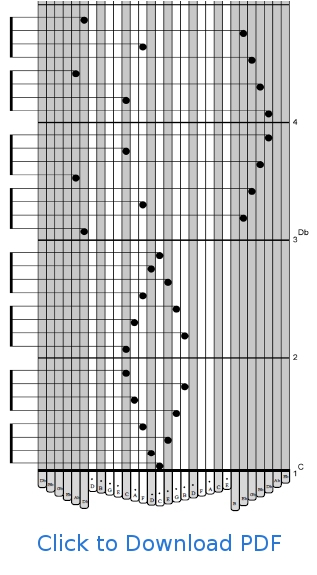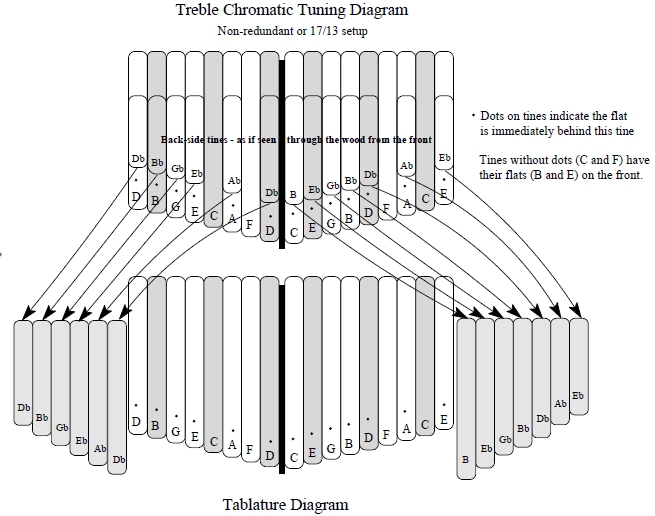Limba Trip is the stage name and YouTube channel for Yohei Kisanuki, an eclectic and amazing player of electric bass and Chromatic Treble Kalimba in Kyoto, Japan. While a number of people have developed competence on the chromatic kalimba, Limba Trip is the most accomplished and most natural player of the Chromatic kalimba that I have seen.
Yohei has approached the Chromatic kalimba as a fully chromatic instrument, capable of playing in any and all keys. As opposed to chromatic instruments, a diatonic kalimba is very forgiving and lets you make nice music even if you don’t really know what you are doing, and on the front of the Chromatic is a simple diatonic kalimba. However, to play at Yohei’s level, you need to know exactly what you are doing, and you need to have all of the Chromatic’s notes at your fingertips. Learn about Yohei’s “limba trip” and get free tablature for the 12 diatonic scales on the Chromatic kalimba.
Kalimba Magic: Yohei, how long have you been playing kalimba?
Limba Trip: About 9 years. I was inspired by the kalimba playing of my hero Paco Sery ( of the Joe Zawinul Syndicate). He is also a great drummer. I started playing chromatic kalimba from 2017 because I wanted to play kalimba in any key. So I had to get chromatic notes.
Watch Paco Sery play Alto Kalimba
KM: How long have you been playing bass?
Limba Trip: About 20 years, since 1998. I love playing Funk, Soul, R&B, African etc..
KM: What is your favorite kalimba?
Limba Trip: The Hugh Tracey Chromatic Treble Kalimba.
KM: Which fingers do you use on the Chromatic Treble Kalimba?
Limba Trip: I use my thumbs on the front-side notes, and I use my middle fingers for the bottom-side tines.
KM: It seems that the chromatic kalimba is much more complex than the regular diatonic kalimba. Do you find this to be true?
Limba Trip: Yes, I think so. The bottom side is difficult, specifically. You cannot see those tines, you can only feel them.
KM: How long did it take you to feel that you were understanding the layout of the chromatic kalimba?
Limba Trip: To understand where the flat notes are on the bottom side is not so difficult. But to play them correctly is difficult.
KM: What do you think is the best way to learn to play chromatic kalimba?
Limba Trip: To play the chromatic kalimba well, you must know where the flat notes on bottom side are by only the feel of your fingers.
For example, I started by repeating the chromatic scale, up and down, very very slowly. And after that, I learned to play all 12 diatonic scales.
KM: That’s great! I myself tend to use the chromatic kalimba like a diatonic instrument on the front side that occasionally uses flats from the back side. But you have taken on the chromatic kalimba as a fully chromatic instrument that can play in any key. Well done!
KM: What sort of wisdom does the kalimba bring to your life?
Limba Trip: I have come to be able to understand music from a totally new perspective since playing kalimbas. It is very important to my life. It makes my life more colorful.
KM: Yes, especially with the chromatic kalimba. Keep on your most excellent path!
 Here is a special gift to you – tablature for the 12 diatonic scales. Click on the tablature here of the C and Db scales to get the full 2-page PDF of the 12 major scales.
Here is a special gift to you – tablature for the 12 diatonic scales. Click on the tablature here of the C and Db scales to get the full 2-page PDF of the 12 major scales.
A note about exactly what you’re seeing here: When you look at the tablature, the back-side tines are represented by all the contiguous shaded columns on the far left and far right… but as if you were looking through the kalimba’s body. The video (below) of Yohei playing the 12 diatonic scales, on the other hand, shows the back-side notes, played with the fingers, on the left of the video and the front-side notes to the right of the video. The front-side notes of the video will be congruent with the tablature – but the back-side notes, as they are seen in the video from the back side (and not “through” the solid body of the kalimba) will be a mirror image of the tablature. Also, Yohei’s Chromatic Treble Kalimba was probably not bought through me, or it would have been painted with the six-tine system rather than the 5-tine system. But at this point, it seems not to matter at all how Yohei’s kalimba was painted some 10 years prior.
Another thing that’s different about Yohei’s chromatic kalimba compared with my tablature is the back side. His version has 17 notes on the front and 17 notes on the back. This is a redundant 17/17 setup – meaning that B and E are both on the front and on the back. My setup here is a non-redundant 17/13 setup, meaning in back of the C and F tines, there are gaps – C flat = B, which is also on the front, and F flat = E, which is also on the front.
That said, Kalimba Magic ships the Hugh Tracey Chromatic Treble Kalimba in both redundant 17/17 and non-redundant 17/13 setups.

Here is that video of Yohei playing all 12 diatonic major scales. There are some buzzy notes in this video – you can learn six different approaches to fixing the buzzy tines.


Sign up for our newsletter and free resources with your email address:
We pinky promise not to spam you and to only send good stuff.
 Christmas in July 2025
Christmas in July 2025 Patriotic and American Music for Kalimba
Patriotic and American Music for Kalimba